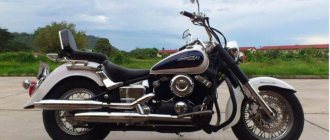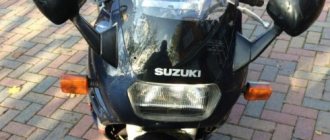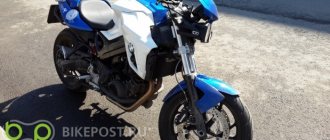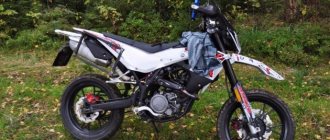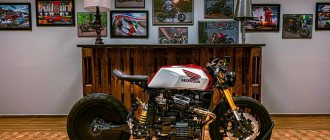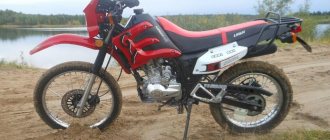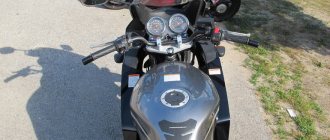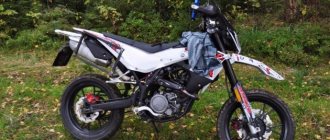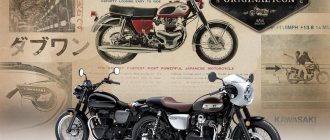Suzuki GRASSTRACKER 250 – scrambler or Big Boy?
The Suzuki Grasstracker 250 scrambler appeared in 2000 as an offshoot of the main Suzuki Volty (TU250) . The model has been in production for 10 years and has undergone a couple of restylings. In 2010, the motorcycle leaves the assembly line, but the stock has not yet been sold out.
A new bike could be bought even in 2022.
Gallery
What about Volty?
An interesting detail is that the release of the retro classic Volty continues.
It has changed several generations , the prefix has disappeared from the name, and its production continues as before. And it can also be noted that this model did not have an official restyling.
Technical characteristics of GRASSTRACKER 250
| engine's type | 4-stroke, SOHC, air cooled |
| Engine capacity | 249 cm3 |
| Engine power | 20.0 hp (15.0 kW) |
| Maximum speed | 120 km/h |
| Drive unit | chain |
| Supply system | carburetor |
| Transmission | 5-speed manual |
| Front suspension | telescopic fork |
| Rear suspension | pendulum, two shock absorbers |
In the form of a motor, Grasstracker received a conventional 4-stroke air-cooled engine with 1 cylinder.
During the restyling process, the 4-valve cylinder head distribution system was replaced with a 2-valve one . According to company representatives, it was made for easier maintenance.
Transmission and clutch
The bikes received a 5-speed gearbox .
According to reviews from the owners, it worked well, turned on clearly, and there were also characteristic clicks. And some opinions flashed that you can switch to a car. From first to fourth, and from fourth to neutral.
The main drive is standard - chain .
Brakes
Being a modification of the retro version, the brakes of the bike were quite simple.
There is 1 disc on the front wheel, and a drum on the rear wheel.
Hydraulic support for the front disc is provided by a 1-piston . In accordance with the retro concept, no frills options were offered.
Driving performance,
The maximum speed of the motorcycle is 120 km/h . As users say, the speedometer sometimes lies a little, so you may not see such numbers, but it’s quite easy to dial them. True, moving at such a speed is not very convenient; a comfortable cruiser is 80 km/h .
Acceleration to hundreds (dynamics
The dynamics of the bike are quite good, but for a retro motorcycle. From standstill to 100 km/h in 7 seconds . According to reviews, “ you can start racing with cars at a traffic light, but when racing in a straight line, the comparison will not be in your favor .”
Fuel consumption
Consumption, according to the manufacturer’s documentation, is 3 liters per 100 km . The average distance at one gas station is 150–200 km (standard tank is 6 l ).
Grasstracker Big Boy
The GRASSTRACKER Big Boy version was produced parallel to the main model and was distinguished by increased dimensions and higher ground clearance.
As already mentioned, the bike itself is considered a modification of the Suzuki TU250 Volty, but it also had its own variation, Grasstracker Big Boy .
Its differences were minimal - wheels of a larger diameter, but at the same time it received its own code.
While the main model had the TU250G, the big guy had the TU250GB.
Competitors
The situation with the motorcycle's competitors was difficult. Only Yamaxa was able to show the scrambler. It was the ST 225 Bronco , which began and ended its journey in 1997 .
The remaining representatives of the Japanese four offered retro models, direct competitors to the main line - Volty.
Peculiarities
The features of the motorcycle included:
- 2 springs for rear shock absorber;
- drum brake on the drive wheel;
- super small instrument panel - speedometer, turn signal and neutral indicators;
- a small glove compartment under the saddle - “to smuggle cigarettes, you can’t put anything else in anyway”;
- low center of gravity, good handling and maneuverability;
- large suspension travel, allowing you to drive even on light off-road conditions without problems;
- reliability - the motorcycle is as simple as a dime, there’s simply nothing to break.
There was also a comfortable fit for people of average height. For tall people, we could recommend the “big guy” (Grasstracker Big Boy).
Conclusion
For the money, the model fully lives up to expectations - a lightweight, simple bike for traveling around the city, fishing or short distances.
A user who got on a motorcycle not immediately after graduating from university, but a little later, is recommended to pay attention to the Suzuki Grasstracker 250. This Japanese device is suitable for a beginner in 2-wheeled vehicles due to its low speed and controllability, which allows you to control and predict a road stop.
It will also appeal to experienced people because of the ability to “drive when everyone is standing still,” save on fuel, and also simply move from one place to another.
And the proud name Grasstracker clearly indicates that, if desired, you can ride a motorcycle off the asphalt and ride through a field or a forest, getting to places where no other SUV can go. After all, this is what a scrambler stands for - a light bike that doesn’t care what the wheels are under – it just rides, carrying its owner wherever he wants.
Of course, the comparison will be subjective , I will try more to convey my feelings after switching from chekushka to liter. I'll warn you right away - there's a lot of text. A few words about buying motorcycles. Suzuki grasstracker BigBoy was purchased in July 2016 at the M... M... showroom, for 150,000 rubles with a mileage of just over 24,000 km, a motorcycle manufactured in 2005. Among the goodies: a different instrument panel, a cool bass exhaust. During all the time it was used for trips to and from work (30 km a day), to Kolomna, to the Zhukovsky Air Show, to Ryazan one day. In total, more than 4000 km have been accumulated so far. During the period of ownership, the following was completed: replacing the battery, tires, chain and sprockets, adjusting the valves, overhauling the front fork, carburetor, changing the oil and filter three times, spark plugs. At the exit, you can add even more than 50,000 rubles to the initial purchase amount. Among the features: 250 cubes, 20 horsepower, 6-liter tank, range to reserve 150 km. AI-95 consumption is from 3 to 5 liters per 100 km. It all depends on the quality of gasoline; after refueling at an unknown gas station in Ryazan, the consumption exceeded 5 liters. The cruising speed was 70-80 km/h, with the new Mitas E-08 tires, according to GPS, the maximum speed was 100 km/h. Africa was purchased from a Japanese auction through the guys K...-O... The idea to buy was born in early February 2022. We participated in auctions three times and, finally, on March 1, my bid came through. On March 14, the spendthrift ended up in a Japanese port. Only then did I receive 40 photographs of the purchase. On April 6, photos arrived after Russian customs. And on April 21, I already received it from a transport company in Moscow. First impressions: the mot fully corresponds to the description from the auction. The main thing is that upon receipt, do not rush to start and drive off the purchased motorcycle: auctioneers sometimes sin by completely draining all technical fluids and, sometimes, removing the battery. My tank turned out to be completely dry!))) Auction inscriptions can be washed off really well with brake fluid, but without saving the fluid itself. And I erased the white marker with nail polish remover. Total: Honda Africa Twin CRF1000L 2016, 19,040 km mileage, new tires, small bumps all around, luxurious roll bars and additional protection, additional tools with the official kit. Price: 603,400 rubles - final price with delivery to Moscow. The same motorcycle with the same body kit and mileage in Moscow at that time cost from 775,000 to 8,150,000 rubles. At first, the hope was that I would start the 2022 season on Grasstracker, remember my skills and gradually switch to Afric. But things didn’t work out with our customs: the package with new stars for the Suzuki was lost after passing through customs and we had to order a new package, fortunately all this was done through the store and overpayments were avoided. As a result, I’ve been on the new Africa since April 21, and the Suzuki was given back to me after service only on May 13. 1000 km have already been driven in Africa: 600 in Moscow traffic jams, 400 in the Vladimir region. First impressions: 1. Heavy - very heavy, at near-zero speeds you are still trying not to overwhelm it, there have already been 4 attempts to catch it, 2 times I managed to catch it, 2 times I still lay down. Results: slightly worn paint on the crash bar and a torn shin due to contact with the motocross stand. When traveling as a couple: you have to fight a lot with side winds at near-zero speeds. But even if you accelerate a little, all the problems go away: the motorcycle does not react in any way to the crosswind and wind of the truck, only the pilot feels the turbulence of the atmosphere. 2. Cross running boards - I decided to highlight them separately. While I was driving around the city I didn’t pay much attention to them, only the small snags on my jeans irritated me. Yes, it is comfortable to stand in a rack. But after traveling to the Vladimir region and back, I decided that I would change it: at engine speeds above 4000, small, infuriating vibrations appear. In the last 100 km I tried to find a position for my legs so that there would be less vibration. You have to think about what to do, since there are no official ones in Moscow, and due to the individual structure of the mounts, universal footrests are not suitable. So far there is an idea to wrap it with rubber from old inner tubes. 3. Engine speed: Suzuki does not have a tachometer, so I control the engine by sounds and sensations. Africa has a beautiful tachometer stripe. First conclusions: up to 2000 rpm - the engine is very drowsy, everything tries to kick. Due to the special structure of the crankshaft, the Crossplane tries to stall like a V-shape: with periodic bursts of bucking. I had to look for the engine power curve. And after that I realized that up to 2000 it’s practically idling, when changing gears, keep the revolutions just above 2000. After that, stable power is produced including up to 4000 - this is already 120-130 in 6th gear (according to GPS 110-120 km/ h). Then, a short plateau - and the next peak of power. But in practice, above 5-6 thousand, the desire to unscrew has not yet appeared, since after 130 km/h unbearable vibrations begin on the cross-country running boards and you have to fight the oncoming flow. Yes, I tried to lie down on the tank, it gets easier with the wind, but it’s not very comfortable. So far the conclusions are as follows: everything above 130 km/h (according to GPS 120 km/h) is temporary and forced. 4. In terms of consumption, the on-board computer announces the following figures: mixed driving style (traffic jams, rare accelerations of more than 100 km/h) - 5.3 l/100 km. Long-distance cruiser - 4.3 l/100 km. In fact, refueling is 6.3 l/100 km for a long distance, the range at this consumption without using the reserve is slightly less than 300 km. 5. Seating: classic - straight back, it is possible to move a little along the chair. The previous owner received a re-upholstered standard chair. Result: after driving for 400 km, the fifth point is soft and a little rotten. But diaper rash can be easily dealt with by driving a little while standing until the characteristic sound of bells rings. Compared to the Grasstrucker (it was also possible to travel 400 km in one day), it’s a real sofa. For rides of more than 50 km, the Suzuki had to wear cycling shorts with a rubber pad in order to somehow protect the butt. After boarding a good fellow, 184 cm tall and weighing less than 90 kg, no discomfort was noted during boarding; everyone lives their own lives and does not interfere with each other. Of course, this also depends on the quality of the suspension; in Africa you don’t need to constantly monitor the road surface. During a daily trip along the repaired Gorkovskoe Highway, almost all defects of the road surface were tested. Africa holds all the vicissitudes of fate without any tangible response to the buttocks and back of the rider. 6. Wind protection: stock glass - up to 130 everything is in a beam, above - pronounced noise appears, which already interferes with hearing the intercom at high volumes. If there is light short-term rain, then you will come home dry and clean, only the toes of your shoes indicate bad weather. If the exposure of the rain is greater and stronger: then nothing will help you. Compared to the completely naked Grasstarker - in almost all weather conditions, driving to and from work will not force you to wear a raincoat. In all the time I’ve been using it, I’ve only arrived once with completely wet pants, and even then, it was the strongest April thunderstorm in the Moscow region. But for a long distance trip I’ll still throw a raincoat in the pannier. 7. Handling and dimensions: in terms of the width of the handlebars, both motorcycles are almost the same - theoretically, crawling between rows should be the same, even the African has more advantages due to the high-mounted handlebars. But in practice, on the Grasstarker you calmly roll between cars, and on Africa you sweat quite a bit due to the pronounced heaviness at near-zero speeds. I agree: this is a matter of habit, on the other hand, if the side of the road allows it, then you stand up and, like a participant in Paris-Dakar, you head towards the goal. On the grass it’s not very comfortable: the low-mounted steering wheel does not allow you to take a stance. In Africa, for this purpose, there are even recesses on the tank for high-quality crimping of the motorcycle with your feet. Conclusions: Grasstacker is more comfortable in the aisle, but Africa can offer an alternative path. 8. Brakes: on the Grasstaker I learned to slow down by engine braking, but after changing to Africa, I stopped noticing the adequacy of such actions on the Suzuki. Africa's engine slows down noticeably, but these are signs of a large-volume twin-pot engine. After Africa, I realized that there were practically no brakes on Grasse, and at the next intersection I increased the distance to the cars in front. I don’t think that Suzukis don’t have brakes - they’re just sufficient for this class of motorcycle and engine size. And yes, Suzuki taught me to take care of the front brake when the motorcycle on asphalt with sand began to fold due to sharp braking with the front wheel. Regarding the pronounced dive of Africa when braking: yes, they are present only if you brake only with the front brake. If you press the rear one in advance, and then actively the front one, then no pecks are noted. Regarding the African brakes: they are of high quality and well controlled. ABS front and rear, switched off at the rear wheel, there is no integrated circuit, each wheel lives its own life. I tried everything on the site to slow down to the mark on the asphalt - zero results, only vibrations on the handle and brake pedal from the ABS. 9. Traction control: Suzuki doesn't have it (haha). I simply managed to unintentionally lift the front wheel into the sky many times before replacing it with heavier, more versatile tires. In Africa, with the most senior level of traction fully engaged, even when a passenger was seated without adjusting the suspension, and even so, during everyday use, the front wheel never tried to leave the ground. You don’t feel that the system is working, just the engine power is dosed to the rear wheel. When driving on mixed ground (pieces of asphalt + soil + sand + pebbles), you feel that the rear wheel slips and crawls a little, but in such a measured way that you have enough to release a moderate dose of adrenaline into your blood for a more accurate understanding of the situation, without panic. 10. Maintenance: with Grasstacker everything is already clear - there are spare parts, but more often on order, the price of maintenance is reasonable. When buying a 2005 motorcycle, I was already aware of certain additional expenses. Self-service: changing spark plugs, oil, filter - simple and pleasant, everything is real and made of iron. If your hands are in the right place and you have experience, then you can completely disassemble and reassemble the motorcycle yourself, the valves are without hydraulic drive, the carburetor is a standard Mikuni. In terms of technical solutions, it often overlaps with the checks of the Russian-Chinese automobile industry. In Africa, things are not so simple: maintenance must be immediate and comprehensive. For example: if you replace the internal spark plugs, you need to remove the radiators from the mount. To move the radiators, remove all the front plastic. And about two air filters - this is no longer a joke: remove the entire lining of the muzzle. That's all the two pieces of plastic are holding. And so we changed the spark plugs. Joke. They checked the fuel lines, but it turned out to be easier to get the internal spark plugs from above than according to the manual, through the radiators. But now it’s no joke, when we were looking for contacts for the cigarette lighter, we found an Easter egg from heaven - the instrument panel cable. So, the first results: filters (air and oil), 4 liters of oil, 2 liters of antifreeze, 1 liter of brake fluid - about 7,000 rubles. To this amount we had to add candles of 7,800 rubles, since during the check the gap no longer fit into any gates. Scope of the first maintenance after purchase: pulling cables, steering bearings, motorcycle chassis, changing oil (4100 ml included) and antifreeze (1600 ml used) and filters, bleeding brakes (500 ml used), installing a cigarette lighter, replacing spark plugs, servicing the rear progression shock absorber, anti-corrosion treatment of contacts and a little bit more - 17,000 rubles. Conclusions when servicing: the front plastic is very fragile, the protective arc of top manufacturers is attached to a delicate spider - it may protect the plastic if it falls, but the spider will definitely lead. Judging by the condition of the progression bolts and spark plugs, routine maintenance needs to be carried out more often than the manual says, for example spark plugs - on 24 thousand they are only checked, but we have to replace them. Maybe the mileage on Japanese motorcycles is also reduced? Pass the fords carefully: the air intakes are high, but if you grab water, you will have to remove the plastic for a long time in order to get to the filters. 11. Muscle memory effect. I decided to highlight it because I’ve already been burned more than once.
It goes without saying that the chekushka must be spun up to its full potential or you won’t go anywhere. According to old muscle memory, when leaving the adjacent territory, I was distracted for a couple of seconds to assess the situation at the additional road. When I glanced at the speedometer, the figure horrified me - in 2 gears in a populated area the speed in Africa exceeded 130 km/h. After this, emphasis was placed on throttle control. After receiving the Grasstrucker from service, I was bothered by the stiffness of the steering wheel when cornering at low speeds. Did the craftsmen really re-tighten the steering bearings? But why is there no such resistance at speed? Only after analyzing the situation, I realized that at near-zero speeds I always cling to Africa with an iron grip, fearing to overwhelm it. Conclusions have also been drawn regarding the management style. And the most difficult section is conclusions . Is there a place for living on the DOP for such a class of motorcycles as chekushki? YES!!! Absolutely, yes. I realized for myself that there is no need to run after engine sizes. I consider my growth path to a liter adequate. The first, Honda CRM 50, answered the question: is it necessary to ride motorcycles at all? The second one (Grasstacker) taught me to see the road situation and know my limits. Of course, there are not enough half-liter ones for experience, but the real situation in the motorcycle industry market is such that it is very difficult to take a fresh tourenduro without a run across Mother Russia and without headaches. Africa is friendly (as long as the traction control is turned on) , and forgives many beginner mistakes, but all this in moderation. This device can be very aggressive and unpredictable, as well as in the speed it can achieve (there are craftsmen who have clocked up to 217 km/h). These two devices have absolutely no overlap in life: on Africa you can fly thousands of kilometers from home (of course, having prepared it and yourself), and on a Grasstrucker, slowly making your way along narrow forest paths, get to the lake near your house. Nowadays, after every ride in Africa, I still wipe the nervous sweat from my forehead, but quietly the mileage has increased significantly. And on the grasstracker I ride, realizing my limits and place on this road and in life, slowly achieving enlightenment and peace of mind. Grasstrucker is real, iron-clad, quietly whispering to you in a deep voice. If you feel that the mixture is rich, then, standing at a traffic light, tighten the carburetor screw and you will roll on. But the main thing is that even now, after every ride on them, I get out of the saddle with a big smile on my face.
Suzuki Grasstracker Big Boy 250
Congratulations to you and us on your next purchase of a training motorcycle. During the training, you will be able to practice on all types of training motorcycle equipment presented in our motorcycle school: Yamaha YBR 125, Stels Flame 200, Yamaha TW 225, Honda cb 400 ss, KTM 200 Duke, Yamaha drag star 400.
In March 2002, Suzuki launched two models: the TU250G Grasstracker and a larger version of the same model, the TU250GB Grasstracker BigBoy. As the name of the model suggests, it has much in common with the TU250 Volty motorcycle, but its design and chassis are more suitable for off-road riding. However, these two models are not pure SUVs, but rather are designed for different driving conditions. Technically, these models are identical, except for some details. The Bigboy model has both a kickstarter and an electric starter. It also has larger wheels and tires. The frame and engine of these models are identical. Despite the fact that the models were released in the 21st century, they have a 70s look and are quite inexpensive. The TU250GB Grasstracker Bigboy was available in yellow/black, white/blue, and black/orange color schemes. The engine of the model is 249 cc 4-stroke with 1 cylinder. Equipped with an air cooling system. Engine power is 20 horsepower, achieved at 7500 rpm. The maximum torque is 21 N•m at 6000 rpm. The front wheel has disc brakes. The rear wheel has a drum brake.
I really enjoyed the lesson with Dmitry! It is immediately obvious that he has extensive experience teaching driving. Yomko succinctly outlined the theory. Everything is to the point and extremely clear. There is still time left for driving in the first lesson. We worked on at least five exercises and, although I didn’t do everything perfectly, I left happy and inspired by the idea that I could master driving. I recommend to all.
There are many motorcycle schools in Moscow: Mosgortrans, Motostadi, Tevalyashka, Mosmoto, Motoobraz, etc. But I studied in Acategory for motorcycle driving courses. I passed the exams for category A on the indoor platform, practiced on the 2nd attempt, and was worried. Retake for free! Motorcycle driving training also took place in a covered, warm, spacious area. The motorcycle park is amazing. I even managed to ride around the city with a new license before the end of the season, and rented a motorcycle at school. Thanks for your professionalism!
I studied with motorcycle instructor Alexey, the goal was to get category A, at first I thought I wouldn’t pass at all and it would be easier to buy a license, in the end I passed the traffic police exam the first time and even took a stunt riding course. I will continue training, there are competitions ahead. The school has beautiful printed gift certificates for driving, it’s not a shame to give such a gift.
Completed a motorcycle driving course. Got a category A license. Excellent driving school in Moscow. Traffic regulations for category A are the same as for category B. The driving area is very large in Vegas next to the go-kart, non-gas-free, warm. You can ride a motorcycle in winter. I recommend to everyone! Motorcycle instructor Nadezhda sorts everything out down to the smallest detail, helps correct mistakes and is very cheerful.
This is a real school for experienced motorcyclists, training on Yamaha tw225, Stels Flame 200, Duke ktm 200. I thought how, having category B, get category A, A1, M. It’s simple - study at the Acategory motorcycle school! They told me how to store a motorcycle in winter, and I went through a safety driving school with them. If you need to learn how to ride a motorcycle, then this is the place for you! The cost is justified by the quality of the material supplied and the rules of operation of the motorcycle controls. Dmitry is fire! Clear and to the point!
I have always felt a craving and passion for motorcycles. I got into this wonderful driving school. I met like-minded people and did not regret it. Category A is open, I passed the exam the first time. They helped me choose my first motorcycle and taught me everything I know now. Roman is the best motorcycle instructor! Very courteous and lively, always there during class.
I passed my license A in Moscow, but came from Saratov. I gained a lot of knowledge and skills. We organized delivery to the Traffic Police, category A is open on the driver’s license. I am grateful to the motorcycle school for a useful experience. Respect to motorcycle instructors Nadezhda and Alexey!
Got category A here! The traffic police exam was not difficult to pass. The best motorcycle school in Moscow! Motorcycle instructors are knowledgeable and experienced. There is a motorcycle storage service with the possibility of training on it in a covered, warm winter area. Very convenient and inexpensive. Thanks to motor school A category!
... I did practice at the Acategory motorcycle school. I advise you - different, unkilled motos, during practice they give everyone a ride. Special respect to the instructor Alexander, he will teach you everything, even if this is your first time riding an iron horse, he will tell you where you need to, and where you need to scold, but everything is to the point. I bought a motorcycle and equipment, passed the exam at the traffic police, and my license with a new category is already in my pocket...
I studied with instructor Alexander, very flexible approach and pleasant communication. Like many people, time is very difficult for me now, but they always found a time that was convenient for me. There are many sites, two of which are covered, which is important in bad weather, normal equipment where everything works (not all motorcycle schools have this). Alexander explains not only how to do it, but also what will happen if you do it differently, which is important for me, because I like to understand why it is necessary to do it this way, and not blindly repeat everything they say. If you have questions or doubts, the easiest thing is to call and personally agree on how and to what extent you need to deal, as I understand, all other questions regarding the purchase of motorcycles and equipment can also be solved. The guys communicate easily and give useful advice for free.
Experience using a Suzuki TU250 motorcycle (Volty, Grasstracker)
Suzuki Grasstracker. We can say that the moto fully met all my expectations - a maximum speed of 120 (according to Jeeps), good lows, simplicity, a lot of available spare parts for pennies (from China and from Japan (used)).
The bike can easily be adapted not only for riding, but also for racing rides - a 12 liter tank from Volti (or from an ST250, I bought it for pennies from Volti) can be installed on a long-distance bike without any modifications. Now I ride around the bay with the stock one - 6 liters (by the way, on asphalt the consumption is 3 liters per 100 km, so with the stock one I almost reached 200 km of run).
For winter driving, I ordered a Chinese hub (gn250) and put an aluminum rim from Chezet (18-inch aluminum) on it on Minskachev spokes. Rims from Minsk, Java and, probably, from everything else are suitable, but the one on hand was from Chezet. All this was flavored by the toothy Petroshin. It turned out to be a pittance. It was possible to bring the rear wheel assembly from Japan (approx. 5 kRub), but the task was to “cut it”...
Suzuki Volty 250. Since this is my first motorcycle, naturally I have nothing to compare with. Therefore, in my eyes it is fast, for 20 hp. not bad at all. Of course, it doesn’t pull away so much that there’s smoke coming out from under the tires, but if you want, you can race the car at a traffic light. During the week's operation, I tried to determine its maximum speed, but since there is no way to get out of the city, I drove around the city.
Up to 100 km/h, acceleration is confident and quite fast, after 100 km/h. less confident, but I can’t say for sure yet.
I got a Suzuki Volty 205 Y (identified by a sticker under the removable seat), black with a non-standard exhaust. Perhaps I would like to say a few words about the exhaust. The standard muffler has a modest and uncertain sound, in my case the sound is loud, bassy and bold. The sound of the Ural motorcycle is very similar, I rode with my father as a child. But I like. They hear me, which means there is a greater chance of being noticed + my helmet is cheerful (bright green is described in the topic “NUT on the head...”), which also helps people notice me. "Passive safety".
I can’t say anything about consumption yet, but I’ve already driven 50 km since the last refueling when the gas ran out. There is fuel in the tank, and in large quantities. According to the Internet, the consumption is from 2.7 liters. up to 4 liters per 100 km. mileage Quite economical.
Driving the motorcycle is not at all difficult; at speed it is easy and unpretentious to control. But at low speeds I have problems, maybe I just don’t know how to drive. I do the same on my bike))))
…..Suspension. Comfortable and soft. Small imperfections in the roadway are absorbed well. On serious bumps it bounces a little, but it’s all tolerable and forgiven.
…..Manual transmission, gear shifting is clear and comfortable. Switching is accompanied by characteristic clicks.
…..Light. Quite bright and wide angle of propagation; if desired, you can plug in a halogen light.
…..Landing. I am comfortable. The saddle is large and soft. People with big butts will fit without problems))))
So, I bought... a 1995 Suzuki Volty. Factory index TU250S. The engine is from an even more ancient (from the 80s) GN250. Power—20 horses. Four valves, overhead camshaft, air cooling of a single pot, one carburetor... everything is simple to the point of primitiveness. BUT! “Cast iron weights don’t break!” And here, too, there is simply nothing to break. The carburetor pleased me with a clever system for adjusting idle speed while the engine is warming up. You pull out the choke before starting, press “Start” and you can go close the garage, put on your ammunition, or just smoke. As it warms up, the lever itself returns to its original position, preventing the mixture from becoming over-rich. Fantastic! :blink: The motorcycle is not much heavier than my previous one, it definitely doesn’t reach 150 kg.
The saddle is low, but not so low that you feel like you are scraping the asphalt with your butt. Not only can you reach the ground with your legs, but you can even stand up above the saddle. The landing, however, is not chopper, but quite classic. The driver's seat is spacious by my standards. During the first kilometers of acceleration and deceleration, I involuntarily moved along it, like tumbleweeds across the steppe. There is a glove compartment under the driver's seat that can hold a couple of packs of cigarettes. Since I don't smoke it's empty

